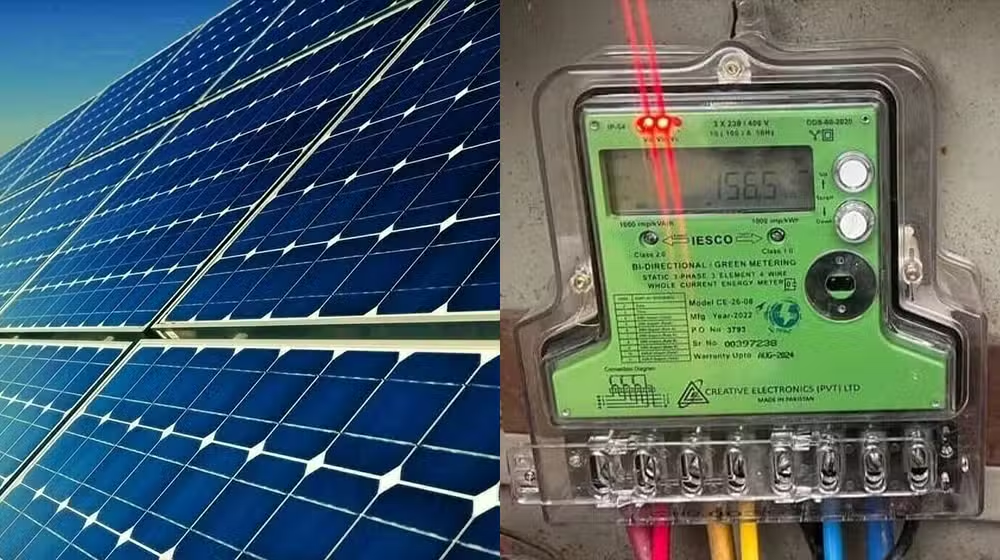The national government is supposed to change the Solar Net-Metering Strategy to change the buyback rate for net metering to the typical energy cost and to build the recompense time frame from three to five years.
This proposition was talked about during an internet based course coordinated by the German improvement office GIZ, detailed Business Recorder.
As of now, abundance energy units from net-metered frameworks are conveyed forward for quite a long time prior to being changed over completely to financial worth and changed against top utilization. A few specialists and DISCOs recommended restricting this period to one month to advance self-utilization and diminish the establishment of curiously large Solar PV frameworks. They likewise suggested laying out a focal cell inside DISCOs to supervise net metering exercises, including the incorporation of housetop Solar PV frameworks and facilitating limit examination.
The course tended to the monetary and specialized difficulties of net metering and investigated answers for make a decent methodology for the public authority, the Solar industry, and buyers.
Pakistan has introduced 2,000 MW of net-metered limit by April 2024, with more than 130,000 frameworks creating 3 TWh of energy every year. Notwithstanding, specialized issues, for example, high customer voltage, dispersion transformer over-burdens, and expanded switch power stream because of unapproved roof Solar establishments were featured as critical difficulties during the course.
The workshop proposed decreasing the net metering limit breaking point to match the endorsed load, like practices in Bangladesh, Saudi Arabia, and India, to forestall transformer over-burdens. Shrewd meters and improved network checking are expected to really deal with the effect of net metering frameworks more.
DISCOs were encouraged to lead facilitating limit investigation utilizing GIS planning to give straightforward data about their organization’s capacity to coordinate Solar PV.
A reasonable duty component was likewise proposed, alongside fixed charges for all customers.
In late conversations inside government circles and the environmentally friendly power area, there has been huge buzz encompassing the possible update of Solar net metering arrangements. The proposed changes expect to broaden the recompense time frame for interests in Solar energy frameworks, a get planned to animate further reception of environmentally friendly power arrangements across private, business, and modern areas.
Current Scenario and Challenges
The way things are, the current net metering strategy permits Solar energy framework proprietors to take care of overabundance power produced once again into the lattice, acquiring credits that offset their service bills. This component has been urgent in boosting people and organizations to put resources into Solar innovation, advancing energy autonomy and manageability objectives. Be that as it may, one of the essential difficulties looked under the ongoing arrangement system is the somewhat short recompense time frame for these ventures.
Regularly, solar powered charger establishments require a significant forthright speculation, regardless of long haul investment funds on power bills and expected income from overabundance energy offered to utilities. The ongoing recompense time frame, frequently assessed between 5 to 7 years relying upon variables, for example, area and framework size, has been an obstruction for a few potential financial backers searching for faster profits from their capital.
Also, vulnerabilities around administrative steadiness and lattice coordination have incidentally made aversion among shoppers and organizations thinking about Solar ventures. Worries over changes in net metering levies or authoritative strategies have sometimes surfaced, affecting financial backer certainty and the speed of reception.
Proposed Policy Adjustments
In light of these difficulties, government authorities and industry specialists are investigating strategy changes pointed toward expanding the restitution time frame for Solar speculations. One of the proposed changes incorporates modifying the computation of credits procured through net metering to mirror a more extended term viewpoint. This change would possibly expand the monetary motivations for Solar adopters, making the underlying venture more alluring by fanning out the return over a more broadened period.
Also, conversations have fixated on improving administrative consistency and straightforwardness to give consolation to possible financial backers. Clear rules on net metering levies, framework access, and interconnection methodology could alleviate vulnerability and work with smoother reconciliation of Solar energy frameworks into the public lattice.
One more viewpoint viable is the presentation of monetary motivators or tax cuts explicitly custom fitted to support Solar reception. Such motivating forces could counterbalance beginning establishment costs, accordingly decreasing the forthright monetary weight on buyers and organizations keen on progressing to Solar energy.
Moreover, partners are pushing for smoothed out authoritative cycles and further developed client service to work on the progress to Solar energy. Endeavors to normalize allowing systems and give available data on funding choices could additionally upgrade the engaging quality of Solar ventures.
Potential Impacts and Benefits
Whenever carried out successfully, the proposed changes to the Solar net metering strategy could yield a few critical advantages for the energy area and the economy at large. Broadened recompense periods would bring down the underlying monetary boundaries related with Solar ventures, opening new open doors for property holders, organizations, and enterprises to embrace environmentally friendly power arrangements.
Expanded reception of Solar energy could add to a more broadened energy blend, decreasing reliance on petroleum products and improving energy security. This shift lines up with worldwide maintainability objectives and positions the country well in the global scene of sustainable power speculation.
Additionally, the extension of Solar limit could create new work open doors across the Solar inventory network, from assembling and establishment to upkeep and backing administrations. This development in the environmentally friendly power area could animate financial turn of events, especially in rustic and underserved networks where Solar tasks could give solid power access.
According to a more extensive viewpoint, decreasing fossil fuel byproducts related with conventional energy sources through Solar reception could add to relieving environmental change influences and working on natural quality. This lines up with worldwide responsibilities to combatting environmental change and advancing maintainable turn of events.
Challenges and Considerations
In spite of the possible advantages, the progress to a lengthy restitution period for Solar speculations isn’t without its difficulties. Cautious thought should be given to the monetary ramifications for utilities and lattice administrators, guaranteeing that any changes in accordance with net metering strategies are adjusted and maintainable for all partners included.
Also, continuous discourse between policymakers, industry agents, and shopper supporters will be urgent to tending to worries and refining the proposed strategy changes. Straightforwardness and partner commitment will assist with building agreement and guarantee that the changed net metering system upholds long haul energy objectives while keeping up with moderateness and dependability of power supply.
Conclusion
All in all, the public authority’s investigation of changes to the Solar net metering strategy addresses a huge step towards advancing sustainable power reception and accomplishing manageability targets. By broadening the recompense time frame for Solar speculations and improving administrative lucidity, policymakers expect to boost more prominent take-up of Solar energy frameworks across private, business, and modern areas.
While difficulties and contemplations stay, the possible advantages — including financial development, work creation, energy security, and natural stewardship — highlight the significance of painstakingly made strategy changes. As conversations develop and partners team up on refining the proposed changes, the result could prepare for a stronger, feasible energy future in the country.

 Business11 months ago
Business11 months ago
 Sports11 months ago
Sports11 months ago
 Entertainment11 months ago
Entertainment11 months ago
 News11 months ago
News11 months ago
 Entertainment10 months ago
Entertainment10 months ago
 General11 months ago
General11 months ago
 Sports11 months ago
Sports11 months ago
 Sports11 months ago
Sports11 months ago
















